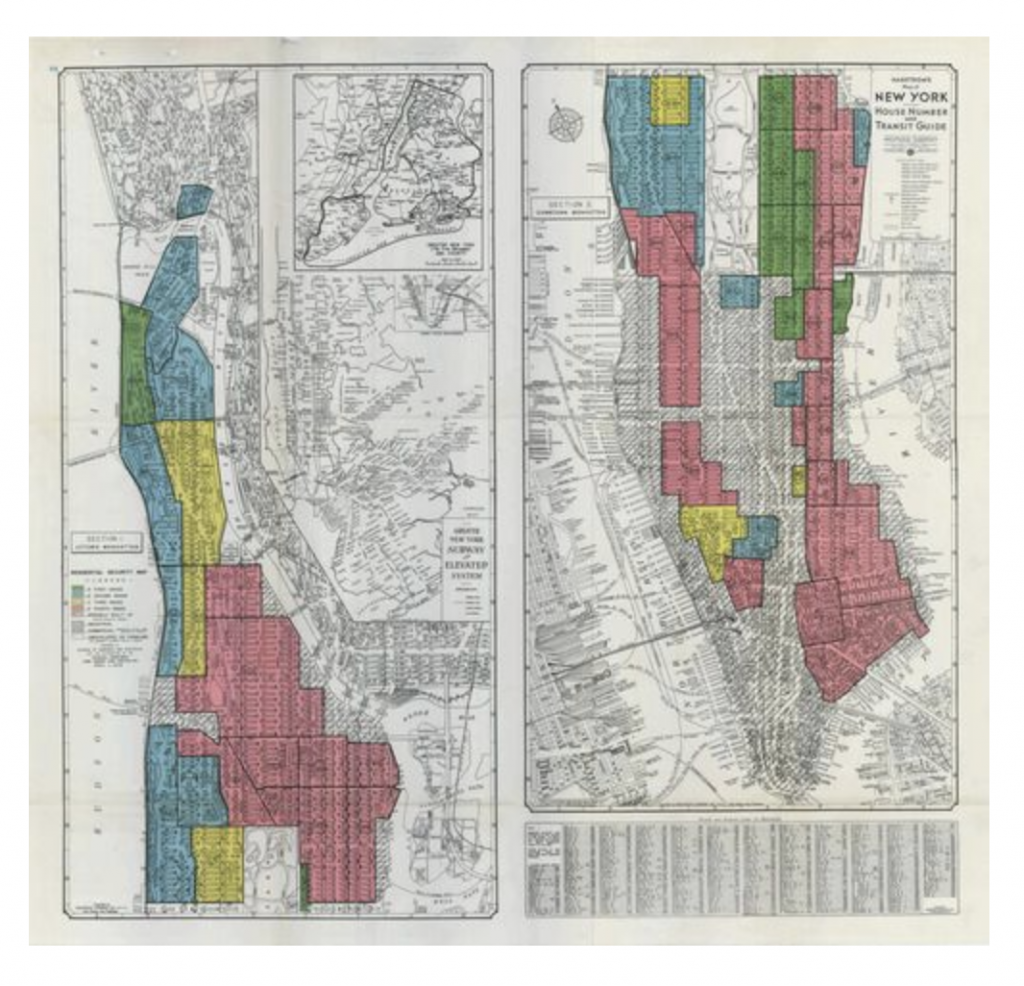This is a submission from our Leaders 4SC Middle School Camp
With the COVID-19 pandemic in full force, schools have shifted to online learning. But in the midst of this, let’s talk about where online learning is happening. Homes. Specifically, the government policy that made homes black and white. We’re going to talk about redlining. Redlining was purposeful, unconstitutional, government policy, not cultural discrimination, that segregated neighborhoods, and as a result, segregated schools.
Now, what exactly is redlining? As mentioned before, redlining was government-mandated discriminatory housing policy that segregated African-Americans and whites into different neighborhoods which had different abilities to get home loans, and therefore accrue wealth.

This is a map from 1943 that shows green, or good neighborhoods for home loans in New York City, as well as red, or “bad” neighborhoods in New York. Notice how the green neighborhoods are on the wealthier and whiter parts of Manhattan, like the Upper East Side, which was mostly white and one of the richest neighborhoods in the city. Compare that to the red Lower East Side, which was filled with immigrants and poor people living in tenement buildings.
As a result, banks and other mortgage lenders commonly rejected loans for creditworthy borrowers based strictly on their race or where they lived. As part of that practice, financial firms, real estate agents and other parties demarcated geographic areas that were effectively off limits for issuing loans. In addition, even when fair housing laws in the 1960s were enacted that prohibited redlining, black families were too poor to move out, so these neighborhoods remain segregated.
Since students have to go to schools in their neighborhoods, and those neighborhoods are still black and white, the schools are also black and white, as well as rich or poor, just not both. According to Stanford University, more than 70 percent of black and Latino students attend predominantly minority schools. Almost 40 percent attend “intensely segregated” schools, where more than 90 percent of students are minority and most are poor. Since redlining segregated our neighborhoods, it caused our schools to be segregated. This is not just bad for diversity. It makes a difference. And it’s hurting our kids. “Poverty rates make a huge impact on student achievement,” writes Stanford’s Linda Darling-Hammond. “Few people are aware, for example, that in 2009 US schools with fewer than 10 percent of students in poverty ranked first among all nations on the Programme for International Student Achievement (PISA) tests in reading, while those serving more than 75 percent of students in poverty scored alongside nations like Serbia, ranking about fiftieth.”
Part of the reason these schools do worse is because of their access to equipment and teachers. Jonathan Kozol’s 1991 Savage Inequalities described the striking differences between public schools serving students of color in urban settings and their suburban counterparts, which typically spend twice as much per student for populations with many fewer special needs. “Contrast MacKenzie High School in Detroit, where word processing courses are taught without word processors because the school cannot afford them, or East St. Louis Senior High School, whose biology lab has no laboratory tables or usable dissecting kits, with nearby suburban schools where children enjoy a computer hookup to Dow Jones to study stock transactions and science laboratories that rival those in some industries.” This shows that white, suburban, and rich schools have much more materials and teachers than minority, urban, and poor schools.
The impact of this perfectly summed up by the Cal State University dissertation of Dr. Erika Emery who said “Educational redlining practices serve as an example of affluent areas utilizing whiteness as property to control accessibility into schools where students benefit from concentrated resources.”
Some people may reject this concept of institutional racism or say it was “de facto” or societal segregation. That would be the easier and more comforting viewpoint. However, as Richard Rothstein, author of “The Color of Law” states, “Residential segregation is an unconstitutional creation of government, a violation of civil rights that should be remedied.” In reality, redlining was created by the government, not our society. It is important that we do not simply put our heads in the sand and pretend like there was and is no problem. We have to listen to the facts, and make sure we understand those facts.
As we fight through this pandemic, it is important to understand how some people have more of a leg up than others, including some of us. We have to confront the hard truths of the past, and make them better to have a brighter future. Redlining was shameful and unconstitutional. We have to listen, even if it is easier to just cover our ears.
Written by Leaders 4SC Student, Amedeo B.
